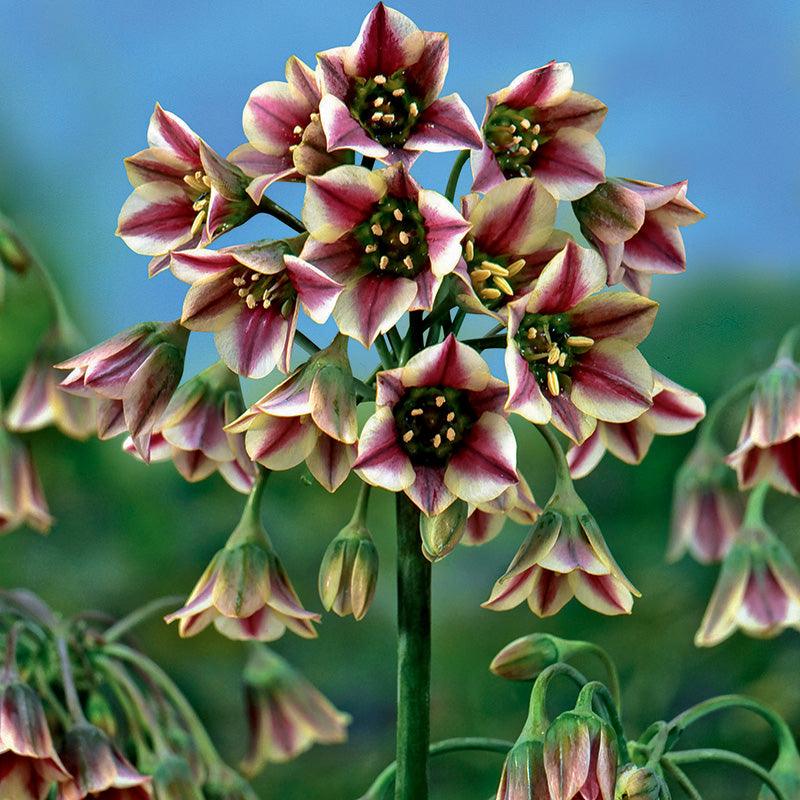Item Number: FB982
Nectaroscordum (Allium siculum) (Pack of 12)
Unique Allium for the Garden
Allium siculum (syn. Nectaroscordum siculum)
Add elegance and exotic flair to your late spring garden with the whimsical beauty of Nectaroscordum siculum, also known as Mediterranean Bells. These enchanting bulbs produce clusters of bell-shaped flowers in muted shades of ivory, green, and pinkish-maroon, arching gracefully from tall, slender stems before rising upright as they go to seed. Easy to grow, deer-resistant, and beloved by pollinators, it offers ornamental charm and ecological benefit in one striking package.
- USDA Zones: 5–10
- Bloom Time: Late Spring/Early Summer
- Height: 36"
- Planting Depth/Spacing: 5"/1–2"
- Deer Resistant: Yes
To learn more about the allium's upkeep and maintenance, please visit our blogs and videos below.
With its tall floral stalks and pendulous, umbrella-like clusters of bell-shaped blooms, it makes a unique architectural statement in perennial beds, borders, and naturalized plantings. Its color-shifting florets and upward-twisting seed heads create dynamic visual movement throughout the season, making this an unforgettable addition to your spring bulb collection.
Key Characteristics and Benefits of Allium siculum (Nectaroscordum)
- Pollinator Friendly: Attracts bees and other beneficial insects during a key transition between spring and summer bloom cycles.
- Deer and Rodent Resistant: Emits a mild onion fragrance that naturally repels common garden pests.
- Low Maintenance: Drought tolerant and pest resistant with minimal care requirements.
- Extended Visual Interest: Decorative seed heads provide architectural value even after flowering ends.
- Unusual Form: Offers a distinctive bell-flower silhouette unlike any other allium species.
Growing Allium siculum Bulbs
Allium siculum bulbs are easy to grow and flourish in many soil types, making them ideal for low-maintenance and drought-tolerant gardens.
Climate and Soil Requirements
Hardy in USDA Zones 5–10, these bulbs prefer well-drained soil with full to partial sun and adapt to varied pH levels and garden styles.
Planting Time and Depth
Plant in fall, 4–6 weeks before frost, about 5 inches deep and 1–2 inches apart, with the pointed end up and grouped for visual impact.
Sunlight and Watering
They thrive in full sun but tolerate light shade and need only light watering after planting and during prolonged dry spells.
Care and Maintenance
Allow the foliage to yellow and die back naturally after blooming, and consider leaving seed heads for visual interest or dried arrangements.
For more tips on caring for flower bulbs, explore our complete Flower Bulb Growing Guide .
Multiple High-Quality Brands for Greater Choice
At Grow Organic, we proudly offer Nectaroscordum (Allium siculum) bulbs from a carefully curated selection of trusted brands. By partnering with multiple premium growers, we ensure our customers enjoy a broader range of bulb sizes, origins, and growing practices—including sustainable and organic options.
Design Ideas and Landscape Uses
Allium siculum bulbs add graceful height and texture to pathways, borders, and cottage gardens, blending well with grasses, iris, and low perennials like geranium and nepeta.
For bold contrast, pair with spherical alliums or foxgloves, or use them in cutting gardens for elegant fresh or dried floral arrangements.
Complementing Other Bulbs
Nectaroscordum siculum complements late tulips, Spanish bluebells, and allium ‘Purple Sensation’ for layered spring displays with height and texture.
As summer perennials grow in, the bulb’s fading foliage becomes unobtrusive, maintaining a tidy and attractive garden appearance.
Explore even more seasonal color for your garden with our Pollinator Flowers.
Check Your Zone Compatibility:
Compatible with your zone.
Growing Zone for

Our Guarantee To You
Since 1976, we've served our customers at every stage of growing. Please contact us at any time. We are happy to support and assist you.
Shipping Information
Shipping Information
Cannot ship to the following states: HI, AK, ID, PR, VI, GU
Shipping Weight: 2.5 lb
Dimensions: 8.0"L x 4.0"W x 4.0"H
Features
Features
- Attracts Bees/Butterflies
- Bulb
Characteristics
Characteristics
Planting & Care
Planting & Care
Useful Information
Useful Information
Guarantee
Guarantee
We guarantee the perishable items we sell to be in good, viable condition when we sell them. Perishable items include, but are not limited to, garlic bulbs, flower bulbs, seed potatoes, onion sets & transplants, potted or bare root trees, vegetable crowns, etc. If your perishable item arrives in substandard condition, take photographs and please contact us within 3 days of the purchase date (or delivery date) and we will provide you with a refund of the purchase price (excluding shipping costs), or a replacement. Accordingly, we urge you to open any boxes marked as ""Perishable"" immediately upon receiving them and inspect the shipment thoroughly (do not crack open heads of garlic, we do not accept claims on cracked garlic). Because some perishable items can deteriorate very quickly, we cannot accept any claims beyond the 3-day time frame as it becomes too difficult to determine if these items were delivered in substandard condition, or if they turned into such substandard condition because of having been improperly cared for or stored once delivered.
Share

I'd forgotten I had planted these, but were unable to miss them once they came up in late May/early June (zone 6). Very striking and unusual, although small and delicate, so they were really overwhelmed by my irises and daffodills.


